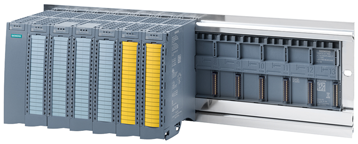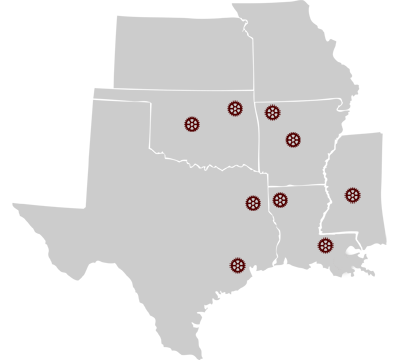- Simatic S7-1500/ET 200MP peripheral modules with 64 channels
- Reduced footprint through high channel density
- Hot swapping: Module replacement during operation enabled by new active backplane bus
- Short installation times with system cabling Simatic TOP Connect
Siemens is expanding its distributed I/O system with new modules for the Simatic ET 200MP/Simatic S7-1500 IOs as well as a backplane bus. A total of four new multi-channel digital modules, with 64 channels each and an installation width of 35 millimeters, enables users to achieve space-saving and cost-efficient implementation of a high number of channels in the control cabinet. This reduces the footprint of Simatic S7-1500 stations. Particularly existing systems on the basis of Simatic S7-300/ET 200M are easy to migrate to the new Simatic S7-1500 systems with the new portfolio.
Hot-swapping of modules is also possible in combination with the new active backplane bus for the Simatic S7-1500 or Simatic ET 200MP. This means you can replace any faulty Simatic ET 200MP modules during the CPU runtime, i.e. during ongoing plant operation, while non-affected modules remain operational, thus increasing your plant availability. The new portfolio makes the Simatic ET 200MP ideal for use in the process environment together with Simatic S7-1500R/H systems since it promotes high channel density and high levels of availability.
Simatic TOP Connect system cabling shortens installation times for the new digital modules since no tools are required. A number of different connection modules are available to find the optimal technical and economical solution for your application. The main distinguishing features are:
- Screw terminal/push-in terminal
- Terminal blocks with/without LED
- Terminal blocks in 1-wire or 3-wire technology
- Optionally sourcing or sinking input/output
Benefits
- Increased system availability due to reaction-free plugging and unplugging of I/O modules during operation; if one or more I/O modules are replaced, the system remains in RUN
- Keeping reserves (= gaps in the system configuration) ready for later use
Typical applications
- The active backplane bus is used in all applications in which high demands are placed on the availability of the plant and even short plant downtimes would result in high costs. Typical application areas are, for example:
- Logistics facilities, such as high-bay warehouses, baggage conveyor systems at airports or letter and parcel sorting facilities in postal logistics, where an interruption in the "just-in-time" chain leads to high follow-up costs.
- Infrastructure systems, such as lighting and signal control in tunnels, water/wastewater treatment in sewage treatment plants or power plants, which must remain reliably in operation around the clock.
- Continuous processes that must not be interrupted due to process control. Examples are wafer production in the semiconductor industry, the manufacture of drugs in the pharmaceutical industry or reactions in the chemical industry.
- Plants that are difficult to access due to their geographical location and which, if a single I/O module fails, must continue to run for a long period of time (a few days) before a service technician can come to the site and rectify the fault. This includes offshore facilities in oil production or wind power plants, for example, as well as compressor plants along gas pipelines.
- Other applications are, for example, signal towers in railway engineering, underground railways or the use of the ET 200MP on ships.
- Many of these plants are operated for 10 to 20 years and are extended over their lifetimes. To keep reserves needed for function extension in the future, the active backplane bus allows you to leave gaps anywhere in the station configuration, which are then equipped with I/O modules when needed.
Benefits
- High channel density in minimum space (width of 35 mm)
- Scalability through mixed module 32DI/32DQ
- Very easy configuring as no parameters need to be set
- User-friendly and flexibly wiring by using SIMATIC TOP connect
- Optimized usability through assignment of channel status LEDs directly at the terminal blocks
Typical applications
Switchgear in power generation and distribution
Switchgear is frequently provided with feedback contacts – provided that it has not yet been interconnected via a fieldbus connection. We recommend that you use distributed stations such as ET 200MP, which are exclusively equipped with digital input cards, in order to read the signals in large, widely spread systems. Due to their high packing density and favorable price, these 64-channel modules are ideal for this purpose.
RELATED ARTICLE





